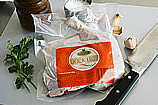How to Cook Duck Legs
Description
Duck Legs have a beautiful rich meat, which is particularly suited to long, slow cooking. Due to their physiology, Duck Legs always come with the drumstick and thigh together. You can remove the thigh bone, for a more convenient serving dish, but a lot of restaurants simply serve with both thigh & drumstick bones intact. Ducks are a waterfowl and have a layer of fat under their skin to keep them warm and waterproof - this is why the skin of a duck is so thick and why so much fat will render during cooking.
For more photos and a video demonstration go to www.nzduck.co.nz
Method
Always thaw your duck legs before cooking.
Smooth the duck legs out and remove any excess fat around the edges. If desired, remove the thigh bone at this time.
Score the skin all over - this will allow the fat layer under the skin to render, during cooking. Be sure to score the skin around the hock of the drumstick. This will expose the bone during cooking, giving the leg a smart appearance when plated. Some chefs actually remove the tip of the drumstick, for a very dramatic effect.
Season with salt & pepper, or your favourite rub. You can leave the duck legs salted overnight, if you so wish.
To 'confit', simply means to 'cook (and preserve) in their own fat'. This is the traditional method of cooking duck legs, but is by no means a particularly fatty way to cook duck legs - believe it or not!
Preheat oven to 150°C or 160°C.
To confit the duck legs, take your salted duck legs and remove any excess salt. Place them in a shallow, but snug fitting oven tray. Pour over clarified duck fat. Clarified duck fat can be purchased from selected stores, or you can have stored it from previous duck dishes you have prepared.
Place the oven tray in the oven and cook for 1½ to 2½ hours at a very low temperature. The duck fat on the scored duck legs will render into the pan also.
When the legs are cooked, remove them from the fat and rest them on a wire cooling rack, for at least 10 minutes.
The fat in the oven tray can be filtered and stored for future use. Alternatively, you can put the rested and drained duck legs into a clean container and pour over the clarified duck fat. Duck Legs will store in the fridge, in their fat, for some days.
To Serve: Preheat your oven grill. Put the drained & chilled duck legs (remove any excess fat, if they have been stored in duck fat) on an oven tray, and place under the hot grill to crisp up the skin. Depending on the temperature when put under the grill, will determine how long they need to be grilled for, before they are warmed through.
When the skin has crisped up and the meat thoroughly heated, serve your duck legs immediately.
Duck Legs particularly suit a potato mash, or potato rosti-style dish, with fresh green beans or leafy greens to offset the rich flavour of the meat.
If you have stuffed the duck legs, the accompaniments may lend themselves more to steamed green beans and roast vegetables.
A fruity jus or glaze would also be recommended to dress the dish, before serving.













